Around the world in 60 daysMal and Tracy's adventuresNew Zealand; north island |
<<Canada<< | Index | >>Australia>> Click on an image to magnify it (JavaScript is required).
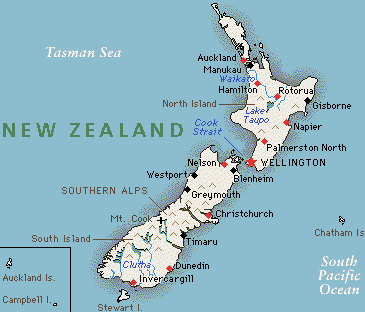 After 3 calendar days
without a bed to sleep in (OK, one was lost passing the date line) and hence
very little sleep, this was not going to be a great day. We hung around in the
airport for a couple of hours waiting for the hire car Co. office to open and
eating a second breakfast. Once installed in our cheap and cheerful Nissan
Sunny, we headed north through Auckland and up the west coast. It was not long
before tiredness caught up and we had to stop for coffee in Helensville. After
that we decided to nip back down the road and up a little peninsular to Shelly
beach. We only did this because the name sounded nice and fortunately the place
was nice too. As coincidence would have it, the beach was entirely made up of
the discarded and broken shells of sea creatures. There was a cafe so we drank
tea. Tracy spotted some accommodation not far back along the road and as we were
both still suffering from jet lag we decided to check it out. The accommodation
turned out to be large Wendy houses scattered on a patch of land by a
bar/grill/pub type affair. We could not be bothered to look for anywhere else so
we took it and after a snooze went to eat steaks at the grill and drink beer
from the bar. It was good but by 10pm we were tucked up in bed.
After 3 calendar days
without a bed to sleep in (OK, one was lost passing the date line) and hence
very little sleep, this was not going to be a great day. We hung around in the
airport for a couple of hours waiting for the hire car Co. office to open and
eating a second breakfast. Once installed in our cheap and cheerful Nissan
Sunny, we headed north through Auckland and up the west coast. It was not long
before tiredness caught up and we had to stop for coffee in Helensville. After
that we decided to nip back down the road and up a little peninsular to Shelly
beach. We only did this because the name sounded nice and fortunately the place
was nice too. As coincidence would have it, the beach was entirely made up of
the discarded and broken shells of sea creatures. There was a cafe so we drank
tea. Tracy spotted some accommodation not far back along the road and as we were
both still suffering from jet lag we decided to check it out. The accommodation
turned out to be large Wendy houses scattered on a patch of land by a
bar/grill/pub type affair. We could not be bothered to look for anywhere else so
we took it and after a snooze went to eat steaks at the grill and drink beer
from the bar. It was good but by 10pm we were tucked up in bed.
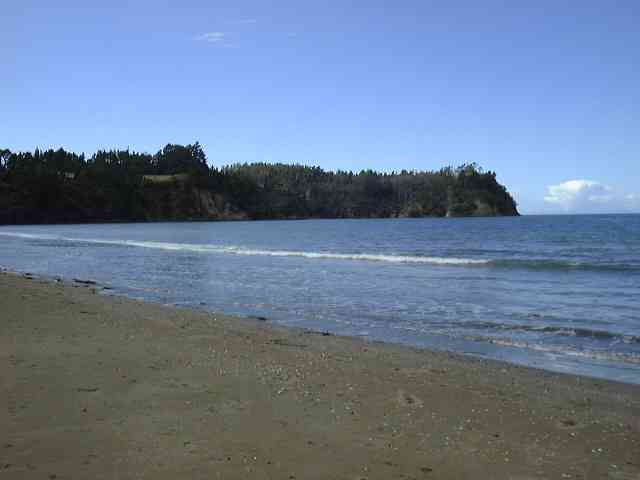 In the morning the sun was shining and the porch of
our Wendy house was quite delightful to sit upon. A cat came to demand our
attention. The only thing wrong was the absence of breakfast. We stopped to eat
at the same cafe in Helensville
and afterwards strolled along their new river-walk path.
In the morning the sun was shining and the porch of
our Wendy house was quite delightful to sit upon. A cat came to demand our
attention. The only thing wrong was the absence of breakfast. We stopped to eat
at the same cafe in Helensville
and afterwards strolled along their new river-walk path.
Heading further north we drive through a historic village which is kind of nice but looks fairly unremarkable. The countryside however is glorious. We stop for lunch at a little teashop run by a jolly little man that purports to sell Devonshire teas.
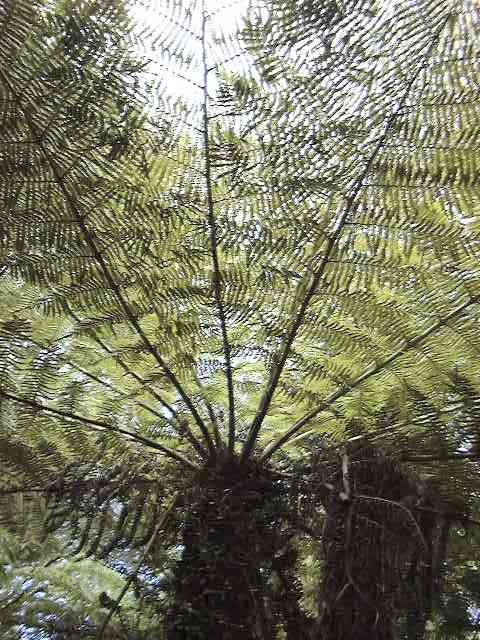
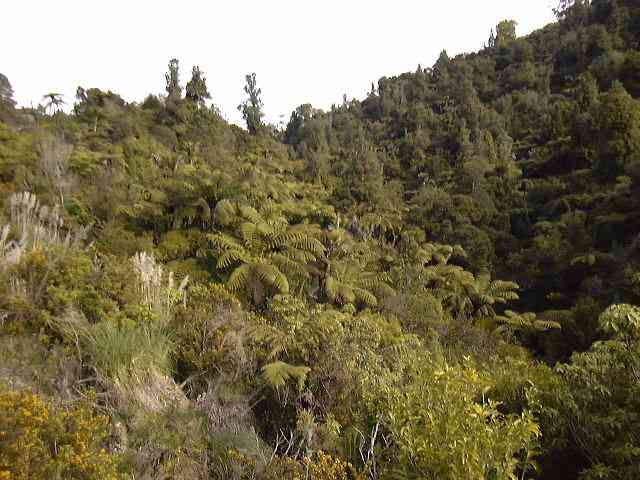 The next stop is for a hike up to a view point in
Dome forest. We make the first view point in good time but on the second half
the path turned to a muddy, slippery descent into the jungle. The hike is well
worth it as we saw many plants unusual to us and some excellent views.
The next stop is for a hike up to a view point in
Dome forest. We make the first view point in good time but on the second half
the path turned to a muddy, slippery descent into the jungle. The hike is well
worth it as we saw many plants unusual to us and some excellent views.
By the time we got back the cafe had closed and the sun was going down so we headed into Wellsford to find a bed and some dinner. We stopped at the first hostel we came across which turned out to be a mistake. On first impressions it just seemed to be a bit run down, which is normal for hostels, but later we discovered there was no heating and the damp had got in giving all the bedding the smell of mildew. I tried warming our room with a toaster from the kitchen but in an otherwise totally unsophisticated hostel they had a smoke detector which noticed the few smoldering toast crumbs and alerted the whole establishment. The Wellsford Inn, DON'T go there!
By way of compensation the meal we had at the El Tapora was excellent, the pizza was out of this world and the Roo steaks were tasty and juicy.
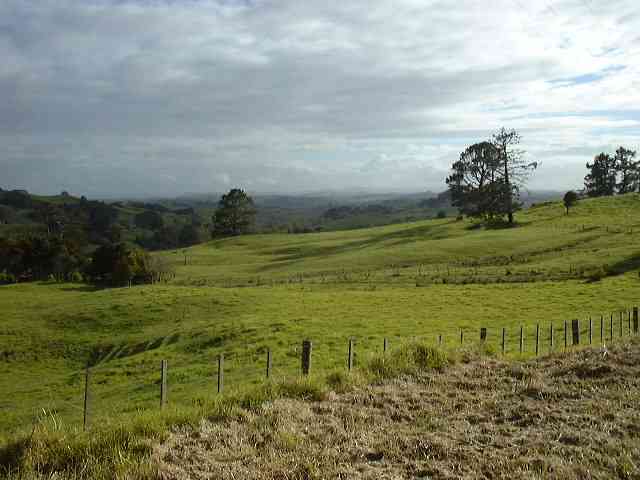 As soon as we wake we pack and leave. Just out of
curiosity we head for Port Albert. We find the town hall but there is nothing
there but glorious countryside so we head off down a track to see more of it and
end up back on the main road.
As soon as we wake we pack and leave. Just out of
curiosity we head for Port Albert. We find the town hall but there is nothing
there but glorious countryside so we head off down a track to see more of it and
end up back on the main road.
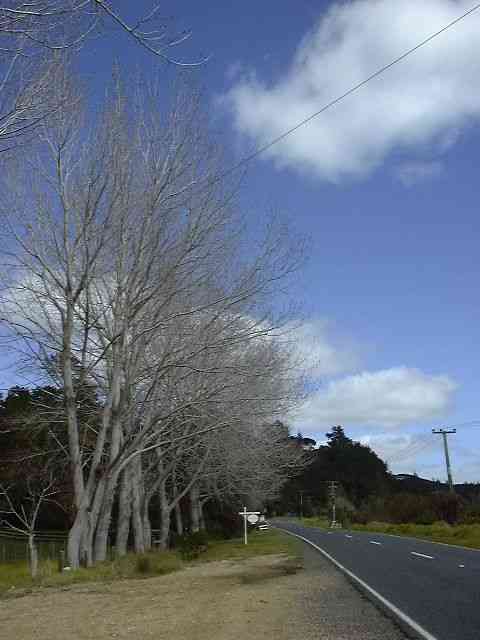 From a distance the rolling hills look much like
England but up close the flora is quite different. Pampas grass grows in amongst
gorse and the woods are sometimes of fir trees and palms. One variety of tree
seems to have white bark and at this time of year when they have no leaves they
look ghostly.
From a distance the rolling hills look much like
England but up close the flora is quite different. Pampas grass grows in amongst
gorse and the woods are sometimes of fir trees and palms. One variety of tree
seems to have white bark and at this time of year when they have no leaves they
look ghostly.
The north island seems to be smaller than I thought so that distances that
look long on the map take only a short while to cover. 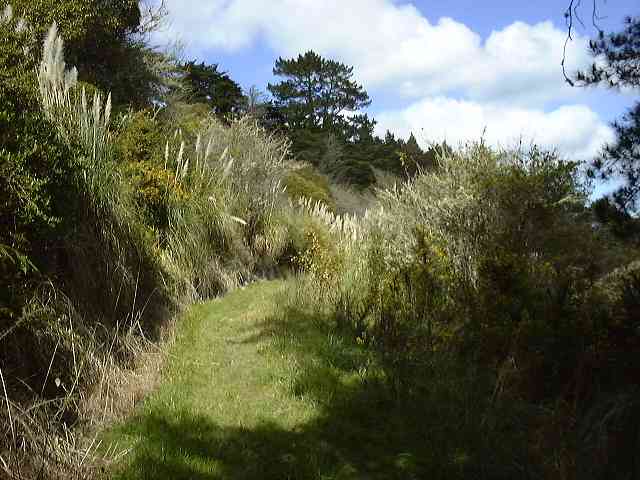 In no time we are in Paparoa
where we stop for a short break but over the little river is a bridge and a walk
to the 'Historic Pa site'. It looks nice so off we go for a walk into the
jungle. OK, perhaps they are just woods but they are quite densely overgrown,
especially if you stray off the path, with its little walkway and steps and all.
In no time we are in Paparoa
where we stop for a short break but over the little river is a bridge and a walk
to the 'Historic Pa site'. It looks nice so off we go for a walk into the
jungle. OK, perhaps they are just woods but they are quite densely overgrown,
especially if you stray off the path, with its little walkway and steps and all.
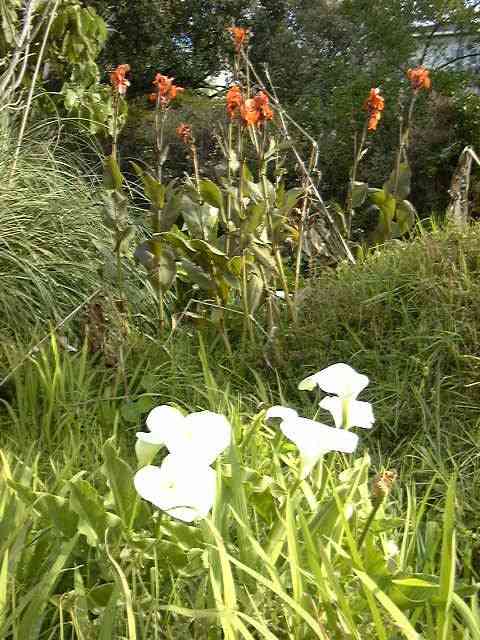 On the way we spot the
famous Kauri tree which is valued by the loggers who chopped them all down.
There seem to be quite a few of them here but they are protected in many areas
now. We knew it was the right tree because it had a little sign nailed to it.
On the way we spot the
famous Kauri tree which is valued by the loggers who chopped them all down.
There seem to be quite a few of them here but they are protected in many areas
now. We knew it was the right tree because it had a little sign nailed to it.
After lunch in a nice little cafe in Paparoa we carry on up highway 12 stopping to think about climbing a rocky peak that had been looming on the horizon for some while but changing our minds when the going got tough.
Our destination today was Baylys Beach where we found a nice little holiday park with a few of our favourite little Wendy houses. Even the cheapest cabin was infinitely better than last nights dump, derelict house.
Once settled in we stroll down to the beach to watch the sun go down over the breakers. Glorious. When you close your eyes you can almost imagine you are listening to the motorway back home.

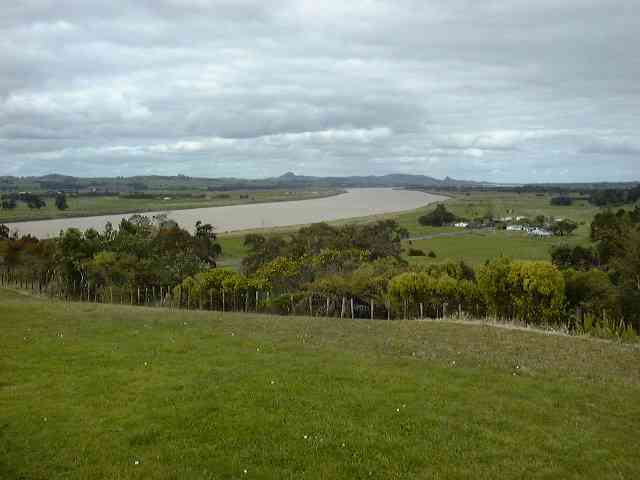
The first stop of the day was the Dargaville
Museum, home to relics of the Greenpeace Rainbow Warrior that was blown up by
the French. 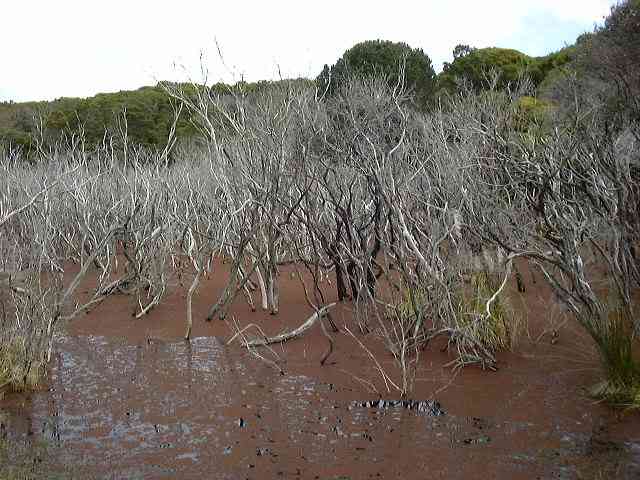 Inside, a large portion of the displays concerned
gum from the Kauri tree.
Inside, a large portion of the displays concerned
gum from the Kauri tree. 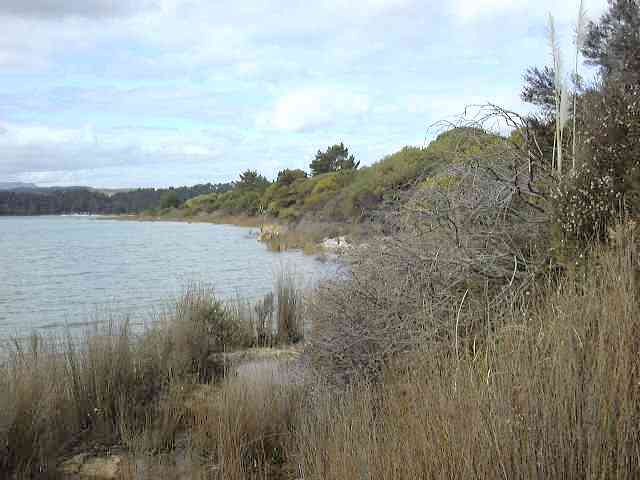 This stuff looked like what we call amber. When cut,
the Kauri tree would bleed gum profusely. The gum became highly valued for
making varnish amongst many other things and so people would bleed the trees and
dig up ancient gum from the ground. Today it is most only used for making
jewellery. Outside the museum the views were worth a gander.
This stuff looked like what we call amber. When cut,
the Kauri tree would bleed gum profusely. The gum became highly valued for
making varnish amongst many other things and so people would bleed the trees and
dig up ancient gum from the ground. Today it is most only used for making
jewellery. Outside the museum the views were worth a gander.
We stop at Kai iwi lakes for lunch while listening to the clear waters of the
fresh water lake lap against the rocky shore. Nearby is a swamp with the
whitened branches of dead trees emerging from waters covered in red algae type
stuff. Spooky!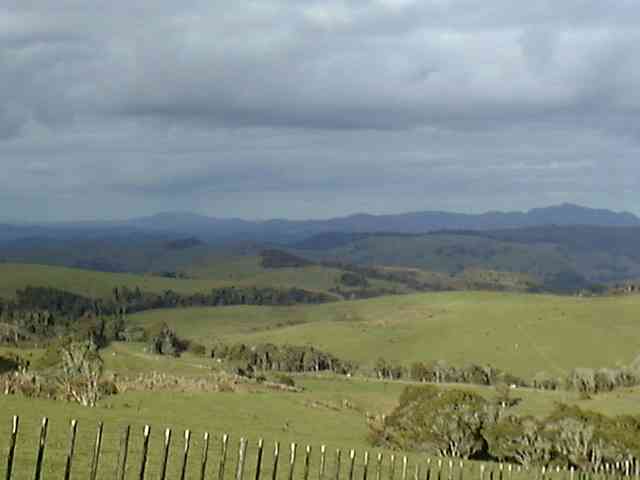
We have to reach Russell in The Bay of Islands that evening but we want to take the scenic route over the range of hills in between. The road we chose soon turns into a dirt track. The going gets slow but it is worth it for the scenery.
A car ferry gets us to Russell where we visit Tracy's grandmother Eileen and her partner Alf who treat us to a nice dinner.
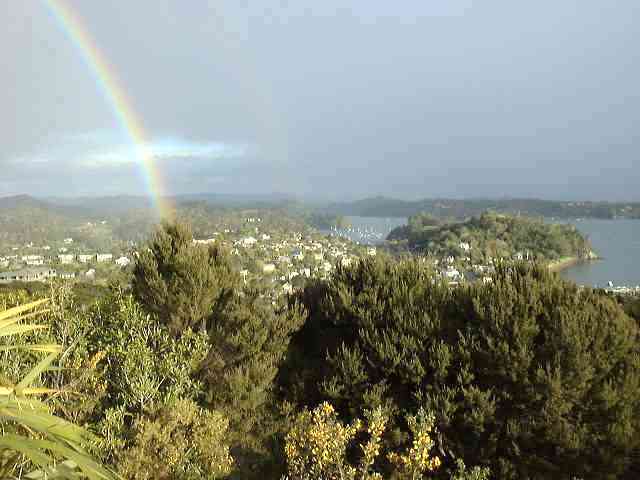 A quiet social day with
Tracy catching up with her grandmother. We did manage to stroll down to and
around town and then up to Flagstaff Hill where the British raised their flag of
authority in 1840 and the Maoris chopped it down again. Four flagpoles were
raised and chopped down until eventually peace settled on the place and the
Maoris raised another flagpole as a good will gesture.
A quiet social day with
Tracy catching up with her grandmother. We did manage to stroll down to and
around town and then up to Flagstaff Hill where the British raised their flag of
authority in 1840 and the Maoris chopped it down again. Four flagpoles were
raised and chopped down until eventually peace settled on the place and the
Maoris raised another flagpole as a good will gesture.
Eileen and Alf cooked us a nice roast dinner in the evening and we chatted some more.
Another lazy day. We managed to drop into the local Internet shop and Alf took us on a tour round some of the bays and his fishing haunts. It certainly seems like a nice relaxed place to live.
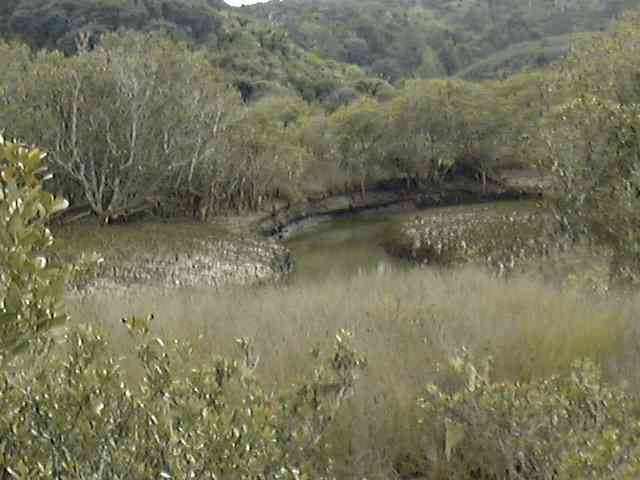 We went off down the coast today to the Kawiti
glow-worm caves at Waiomio.
On the way we stopped of to see the 'world famous' public toilets created by an
Austrian artist who lived in New Zealand. They were decorated in the style of
Gaudi with old bottles and bits of broken stuff like bathroom tiles and
machinery.
We went off down the coast today to the Kawiti
glow-worm caves at Waiomio.
On the way we stopped of to see the 'world famous' public toilets created by an
Austrian artist who lived in New Zealand. They were decorated in the style of
Gaudi with old bottles and bits of broken stuff like bathroom tiles and
machinery.
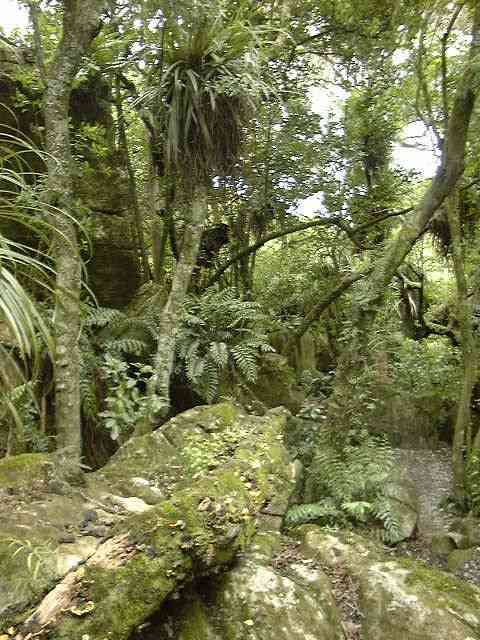 |
A guide took us through the caves telling us about all the similarities between the limestone features and famous personalities, animals and rude parts of the anatomy. The glow-worms themselves were like short pieces of noodle with a light at one end. They hang about on the ceiling of the cave luring flies into their nets of sticky beads with their alluring glow. They do this for 9 months before changing into a chrysalis and then hatching out as a fly. If they are lucky enough not to be caught in their neighbours net, they have 3 days to mate and lay eggs before dying. It all sounds rather depressing really. Their only saving grace is that they create a really good display even during daylight hours when they only glow at half brightness.
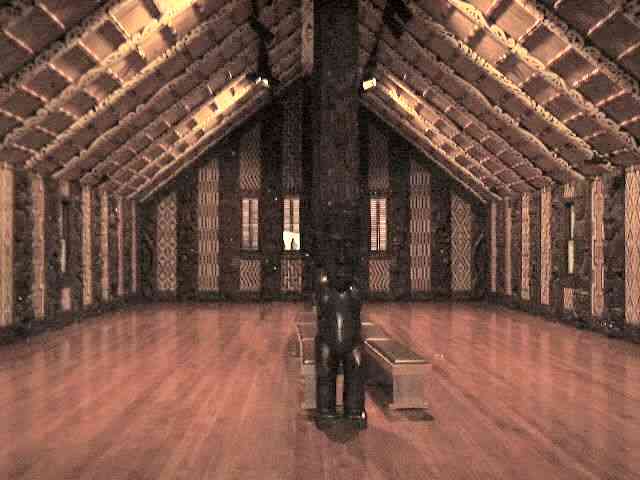
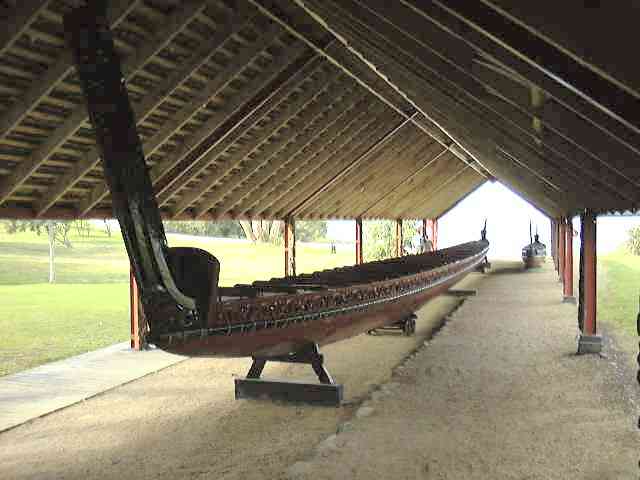 Back up the coast we check out the Waitangi
treaty grounds where in 1840 Captain William Hobson convinced many Maori chiefs
to sign a treaty with the British government giving the British sovereignty over
the whole country. The house used as the British Residency still stands near by
where the treaty was signed and a 'Te Whare Runanga' (meeting house) has been
built nearby for all people to use.
Back up the coast we check out the Waitangi
treaty grounds where in 1840 Captain William Hobson convinced many Maori chiefs
to sign a treaty with the British government giving the British sovereignty over
the whole country. The house used as the British Residency still stands near by
where the treaty was signed and a 'Te Whare Runanga' (meeting house) has been
built nearby for all people to use.
After a short walk along the coast we had to head back to our attentive hosts for yet another lovely dinner.
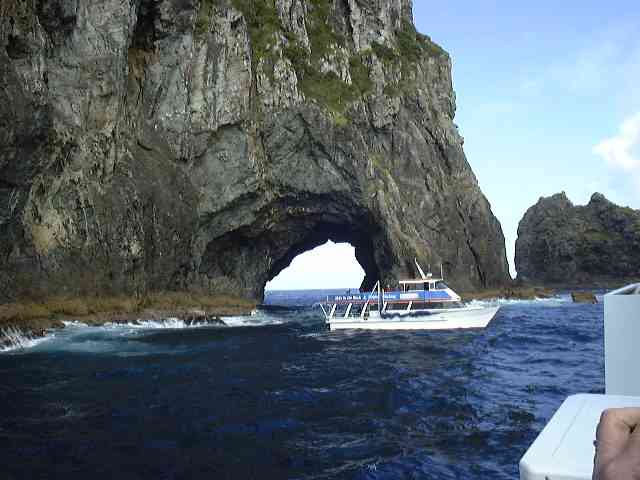
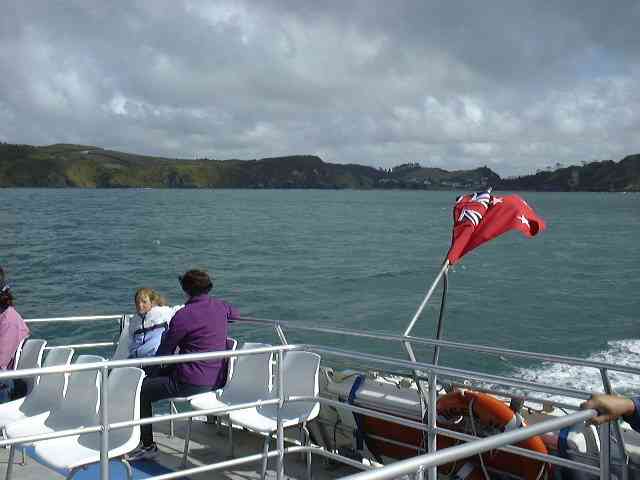 Despite the showers this morning we took a run over
the hill and along Long Beach. Fortunately the beach did not live up to its name
but it was the most scenic run I have ever taken with wooded hills to one side
and gentle waves breaking on the sandy shore on the other.
Despite the showers this morning we took a run over
the hill and along Long Beach. Fortunately the beach did not live up to its name
but it was the most scenic run I have ever taken with wooded hills to one side
and gentle waves breaking on the sandy shore on the other.
Alf's fishing friend Mike drops by with some oysters and warns us that the following day will be a bit rough out on the water so we dash down to the pier to catch the 1.30 pm cruise round the Bay of Islands.
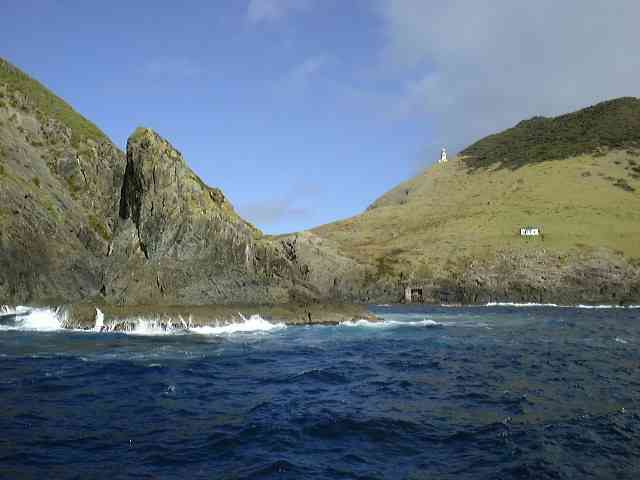
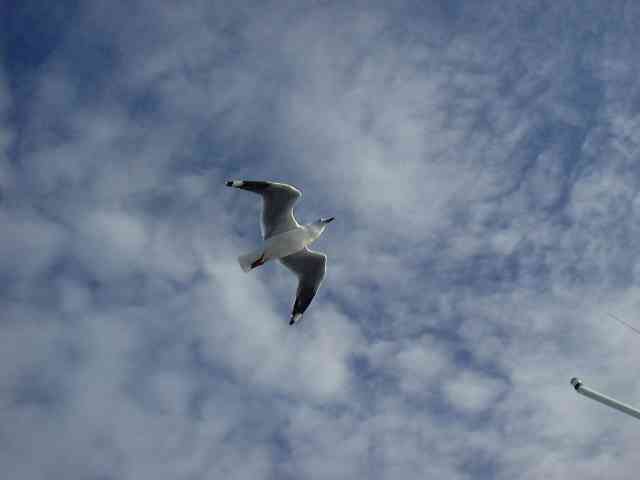 There are more little islands and bays than you can
shake a stick at. We stop at a few including some that have been bought by rich
folk. Fortunately they cannot buy the beach or 20m up from the high tide mark so
us poor folk can still go ashore without being shooed off. Our boat heads out to
sea so that we can see the 'Hole in the rock' at Motukokako island. The sea is a
bit rough this day but otherwise we would have sailed through the hole, instead
the captain reversed in a bit so that we could see the geological features and
all.
There are more little islands and bays than you can
shake a stick at. We stop at a few including some that have been bought by rich
folk. Fortunately they cannot buy the beach or 20m up from the high tide mark so
us poor folk can still go ashore without being shooed off. Our boat heads out to
sea so that we can see the 'Hole in the rock' at Motukokako island. The sea is a
bit rough this day but otherwise we would have sailed through the hole, instead
the captain reversed in a bit so that we could see the geological features and
all.
Eileen's friend Margaret had invited us all to dinner that night, and a good dinner it was too. They have a house on a hill overlooking the bay where the ferry crosses to Opua on the mainland and the scenery is spectacular.
Alf cooked us a rather large breakfast of eggs, bacon, tomatoes and battered
oyster. A little bit much for breakfast so we skipped lunch. This being our last
day we thought we had better check out the town of Russell. 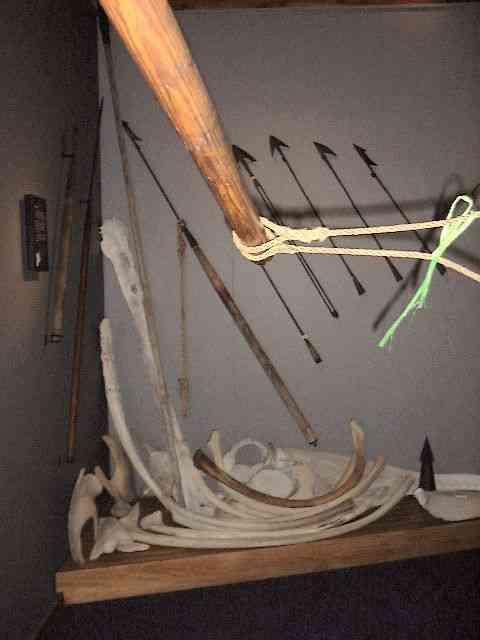 The museum was just the
right size, running out of things to look at just as my interest in museums ran
out.
The museum was just the
right size, running out of things to look at just as my interest in museums ran
out. 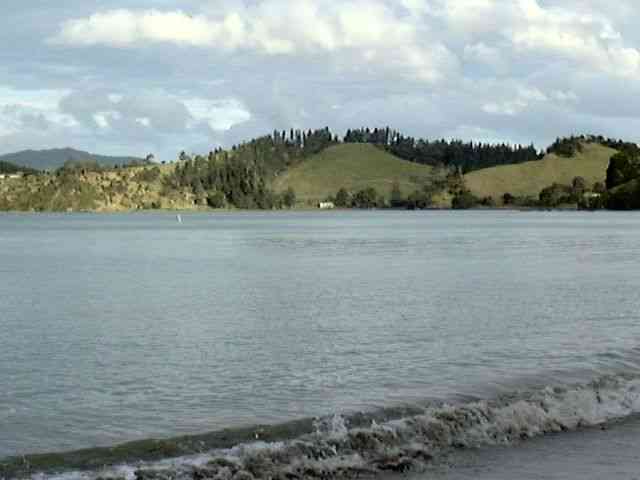 This turned out to be the
most rainy day we had had with monsoon style rains gushing from the skies. We
sat in a coffee shop and watched. When the downpour abated we nipped between the
remaining raindrops to peep at Christ Church, the oldest church in New Zealand,
then onto Pompallier House, one of the oldest houses in New Zealand. Mind you,
what passes for old here is often only 150 years. A quick peep in the visitor
centre and we headed back up the hill to our hosts. We were a bit early for
dinner so Alf took us out to see his favorite bay, Paroa Bay, where he often
goes fishing.
This turned out to be the
most rainy day we had had with monsoon style rains gushing from the skies. We
sat in a coffee shop and watched. When the downpour abated we nipped between the
remaining raindrops to peep at Christ Church, the oldest church in New Zealand,
then onto Pompallier House, one of the oldest houses in New Zealand. Mind you,
what passes for old here is often only 150 years. A quick peep in the visitor
centre and we headed back up the hill to our hosts. We were a bit early for
dinner so Alf took us out to see his favorite bay, Paroa Bay, where he often
goes fishing.
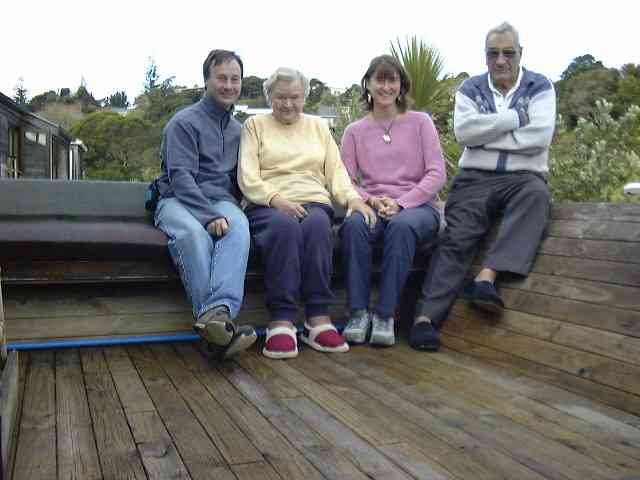 We leave Russell today and
it feels a bit like leaving home. Alf and Eileen have made us very welcome and
spoilt us something rotten. Alf even cooks us yet another big breakfast of eggs,
potatoes and flounder given to us the day before by Alf's friend Mike.
We leave Russell today and
it feels a bit like leaving home. Alf and Eileen have made us very welcome and
spoilt us something rotten. Alf even cooks us yet another big breakfast of eggs,
potatoes and flounder given to us the day before by Alf's friend Mike.
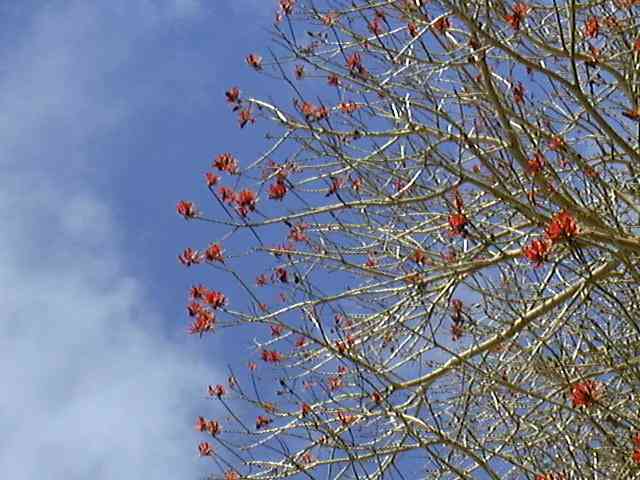 |
We take the car ferry over to Paihia and then highway 1 and then 12 to the
east coast. As we get close to Hokianga
Harbour we spot a white mountain behind the next mountain in front of us. As
we are trying to work out why it may be white, we round the last bend to
discover that the white mountain is covered in sand. The sides are too steep to
be a sand dune so I figure it must be rocky and covered by sand blown over it
from the beach beyond. 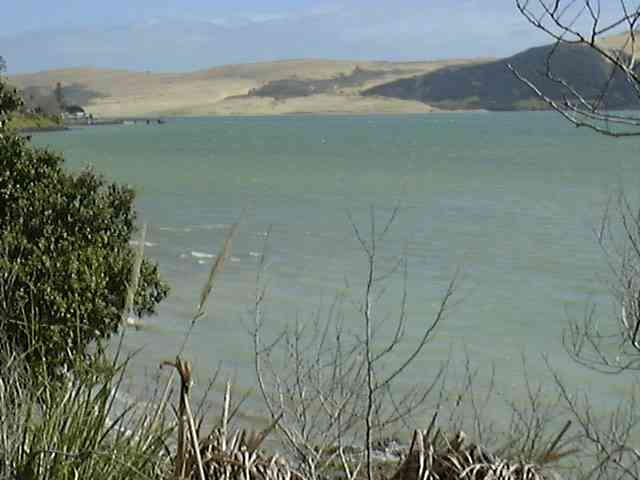 It makes a strange sight across the harbour from the
green hills surrounding it. We stroll out to the view point to see the Tasman
sea breaking on the sand bar that stretches along the coast.
It makes a strange sight across the harbour from the
green hills surrounding it. We stroll out to the view point to see the Tasman
sea breaking on the sand bar that stretches along the coast.
Just down the coast is Waipoua Forest where we take a walk to see the largest
Kauri tree in New Zealand, then the 7th largest, and the 4 sisters (all Kauri
trees) in a forest of Kauri trees, palm, cabbage and fern trees.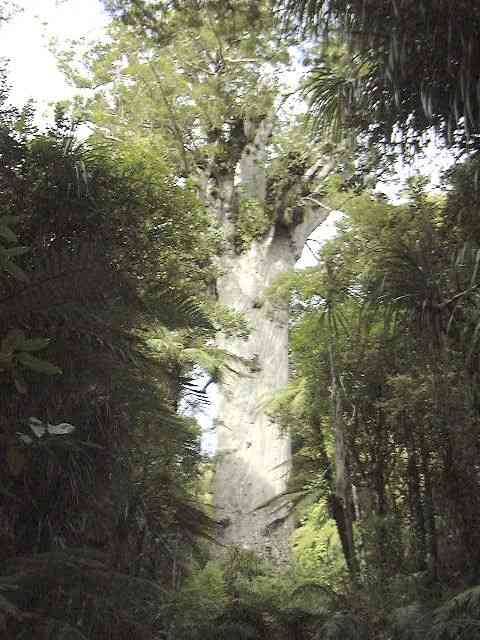
Further through the forest we stop at the visitor centre and book a cabin for the night. The ranger tells us that the nearest place to find provisions is at the petrol station south on the main road and that if we hurry we may get there before they close. The petrol station turns out to be 20 km south and by the time we realise it is past closing time. We end up driving about 60 km south, past the Baylys Beach where we originally planned to stop for the night and into Dargaville just to find some tucka. Fortunately we found a top restaurant (Uno Restaurant) that made it worth the drive.
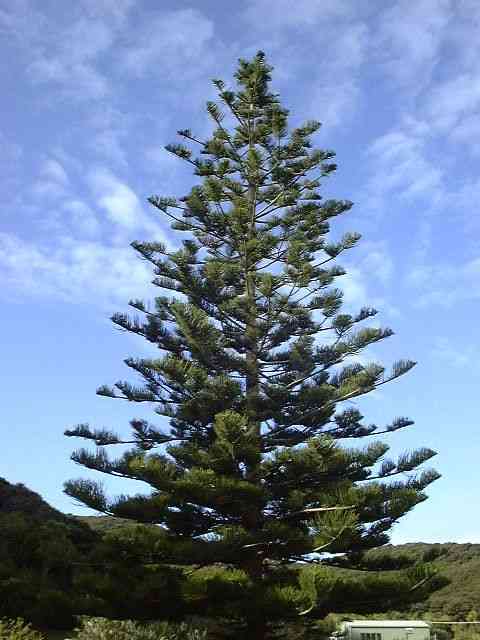 We woke to the sound of birds in the forest.
Strangely enough this was the only cabin that we had stayed in that was made out
of breeze blocks rather than logs. Perhaps they were trying to conserve the
forest but it kind of detracted from the effect of a log cabin in the woods. We
breakfasted on fruit and water as the only place for breakfast was still
Dargaville 60 km away.
We woke to the sound of birds in the forest.
Strangely enough this was the only cabin that we had stayed in that was made out
of breeze blocks rather than logs. Perhaps they were trying to conserve the
forest but it kind of detracted from the effect of a log cabin in the woods. We
breakfasted on fruit and water as the only place for breakfast was still
Dargaville 60 km away.
The day was taken up mostly by driving as we had to get close to Auckland ready for our flight to Australia the next day. Still, the scenery was good and we managed to stop a few times to admire the view.
We manage to find a nice little cabin by the sea at Waiwera for the night and dinner in a pub at Orewa, the next town down the coast.
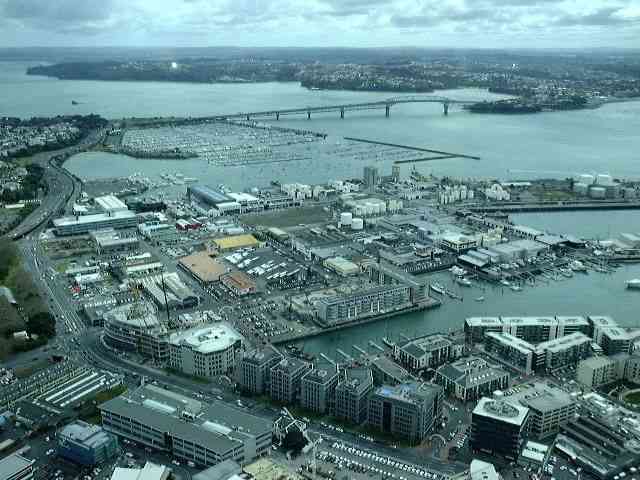 We awoke today with the sun glinting off the calm
sea and spent a little while just basking in the sun and walking along the
coast.
We awoke today with the sun glinting off the calm
sea and spent a little while just basking in the sun and walking along the
coast.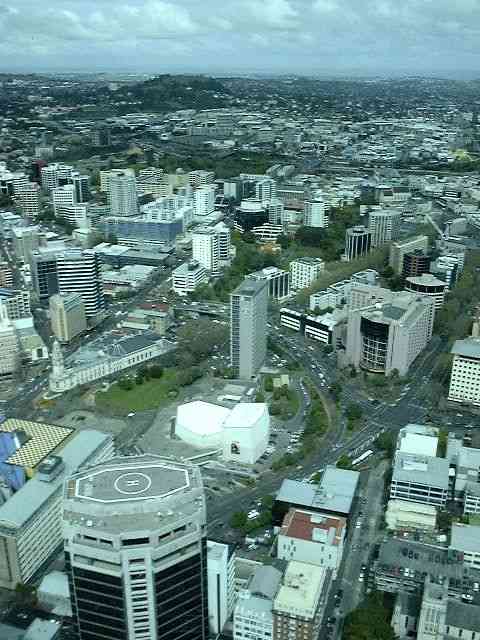
In Auckland we stopped to ascend the SkyTower for a quick look at the view. It turns out to be spectacular, encompassing many harbours, bays and an extinct volcano.
Well that's it for our quick trip to the rural north of the north island. Its a beautiful place and I am sure we will be back again.
Later on, in Melbourne, our good friend Chris picks us up from the airport and after a scenic evening drive on the motorway we find ourselves in Chris' 18th floor apartment overlooking the business district of Melbourne feasting on orderves.